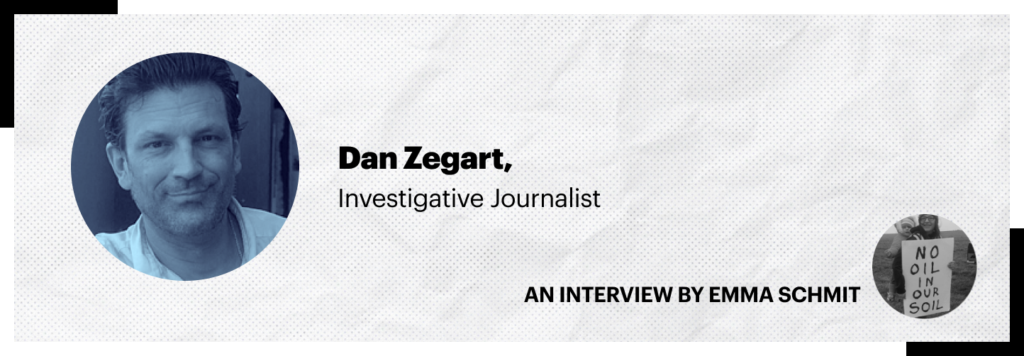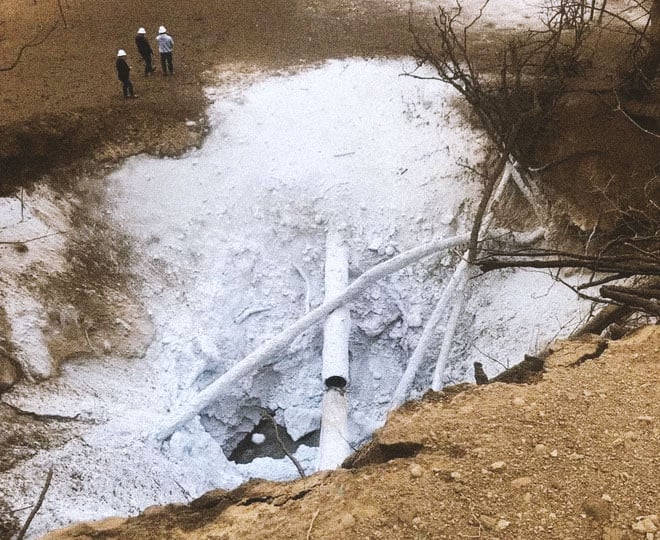Two years ago, on a quiet winter night in the small town of Satartia, Mississippi, a fog sucked the oxygen out of the air. Cars rolled to a stop. Folks collapsed in their homes. The culprit — a nearby carbon pipeline had ruptured.
Dan Zegart was the first national journalist to investigate the catastrophe, which hospitalized 49. Now, he’s covering the fight against pipelines in Iowa, where three corporations are plotting 3,000 miles of pipeline.
These pipelines are part of the dirty energy industry’s newest scam: carbon capture and storage. Companies claim that they’ll store the CO2 carried by these lines safely underground. That they’ll help reduce emissions and fight climate change. But it won’t work, and it’s not safe.
In an interview with our Senior Iowa Organizer Emma Schmit, Dan lays out dangers and risks of carbon pipelines. This interview has been edited for clarity and length.

“I Was Surprised By The Sheer Level Of Chaos.”
You broke the story on how dangerous these pipelines can be. What took you by surprise going into it?
The people in Satartia were not prepared. They were not notified by the company that this could happen. They had very little knowledge about the pipeline, and that didn’t really surprise me that much.
But what did surprise me was the graveness, how bad the injuries were. People who had COPD under control who are now on inhalers full time. People who are disoriented still, have memory problems. One of the most seriously injured people can’t recognize his friends on the street. He can’t hold a job because he can’t remember what he’s supposed to do.
I was surprised by the sheer level of chaos that this caused this little place. And the heroic, almost battlefield mentality of the first responders who went in.
The folks who had been overcome by CO2 were wandering around, disorientated. Their cars had stalled because the CO2 displaces oxygen. They wandered into town, had absolutely no idea where they were.
When one of the first responders got to this one couple, they were so out of it he had to scream at them, “Get in my truck or you’re gonna die!” They still didn’t understand, so he had to physically put them into his truck.
So think about that in the context of, let’s say, a break near a school, an old folks home, a strip mall. What’s gonna happen to those people? How are they gonna get to them without internal combustion engines? They’re not! There’s no guaranteed path to safety.
Carbon Pipelines Are “A Much More Hazardous Type of Pipeline.”
What did the accident at Satartia teach us about carbon pipelines?
We found that you can’t necessarily predict where the plume of CO2 is gonna go, how long it’s gonna be in the air. All the models that had been done to predict it — those were all wrong. So we’re back to the drawing board as far as engineering these pipelines.
It’s back to the drawing board for public health, too, because no one knew it could have this kind of impact. And it’s back to the drawing board on the regulations side, because we know we need stronger safety regulations and much more scrutiny on this technology.
The ones talking about carbon pipelines say, “We’ve been able to do it with this product, we can do it with CO2.” Nope! You can’t. It’s not something that should just be grandfathered in as, “Oh, it’s just another pipeline.” It’s actually, in many ways, a much more hazardous type of pipeline.
The people in Satartia were the guinea pigs. They were sacrificed for this technology. And unless we want a lot more sacrifices like that, we better put a stop to this because we don’t know what we’re doing.

Big Oil Knows That Carbon Pipelines “Allow Them To Stay Alive Longer.”
What are your thoughts on these three pipelines proposed for Iowa?
These companies jumped in for no other reason than the federal government is offering a tremendous amount of money for carbon capture and sequestration projects to be built.
The amount of carbon that they’re actually going to sequester is tiny compared to what’s already going into our atmosphere. Trivial. If the current proposals for carbon capture were all built, and we built the additional 65,000 miles of pipeline to accommodate them, that would only take care of about 15% of current emissions.
But emissions are continuing to go up, and that will become an even smaller percentage. And in the meantime, we’re gonna forgo opportunities to produce less carbon, as we move through the century.
Why, after knowing all the safety concerns, how this technology doesn’t work, are we still trying to make carbon capture happen?
Because the oil companies have realized that the prospect, even the idea of carbon capture, allows them to stay alive longer. Maybe they’ll never have to change if we bury the emissions.
Unfortunately, carbon has no value. CO2 is the industry’s waste. So they’re forcing taxpayers to pay to throw out their garbage. Nobody else gets paid to throw out their garbage. We don’t subsidize restaurants to throw out their rotting fish. That’s up to them.
“No One Wants To Be Poisoned.”
In Iowa, this issue has brought your standard rural Republican together with your left wing Democrat. Why has this issue resonated and overcome the divide that has grown over the past decade?
First of all, it attacks what in many ways is a fundamental value in our democratic system, in our capitalist system, which is that private property is sacrosanct.
If you can’t own your own land without some for-profit company coming in, and their product is not even gonna help you, then anybody could do it. Some landowners went through that already with Keystone XL or the Dakota Access Pipeline. They’re not having it this time.
And I think the other issue that’s brought this very unusual coalition together is safety. No one wants to be poisoned, and there’s a good chance of that with these pipelines.
It’s extraordinary because I’ve been in meetings where you have 100 farmers and 15 or 20 people who are definitely on the climate side of things. You’ll have people who voted for Trump, people who voted for Biden, or Bernie, or whomever, and that stuff doesn’t ever get in the way.
People just talk to each other as neighbors. That’s the American way, you know. Coalition-building. It’s supposed to be. You have the makings of a movement in people talking to each other, people putting their differences aside. There aren’t many examples of that in American life in 2022.
We Can Stop Carbon Pipelines When We Stand Together.
What would you say to folks who are currently fighting pipelines near them?
I’ve covered 10 or 12 of these pipeline fights. They weren’t carbon pipelines, because this is the first time this technology is being built. But in those dozen or so, a few of them have failed. The infrastructure was rejected, or the people who were funding it had had enough.
With the Atlantic Coast Pipeline, one of the biggest projects on the drawing board was stopped dead. Investors pulled out. The Mountain Valley Pipeline was all but done before this whole side deal came up between Biden and Manchin.
There’s tremendous resistance that’s been built. So if you don’t think you can stop this — it can be stopped. And the common element in all the successes is people standing together.
Iowans, tell the state Utilities Board to say NO to dangerous carbon pipelines!


